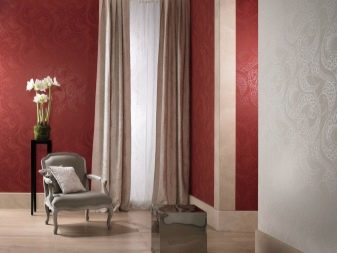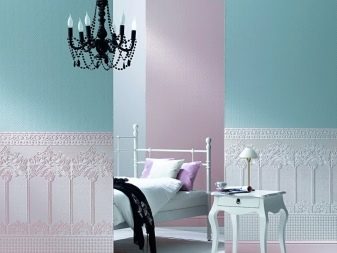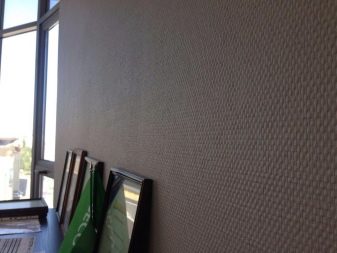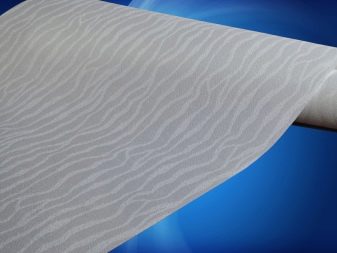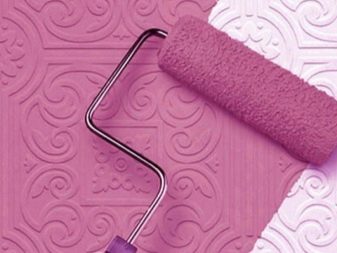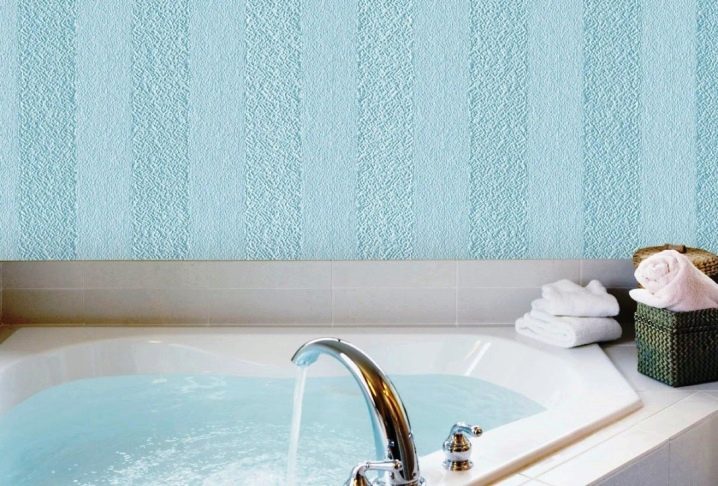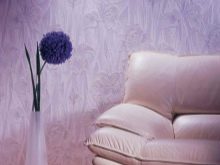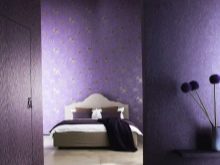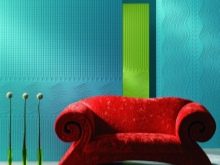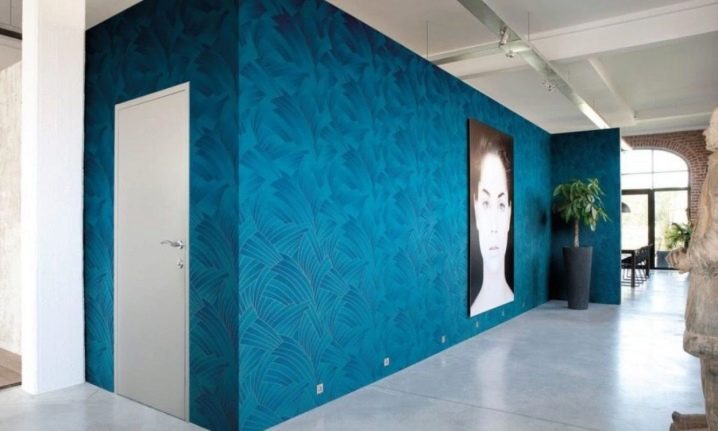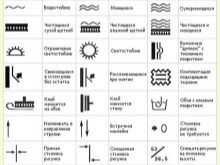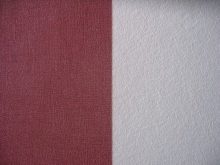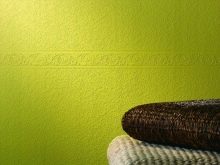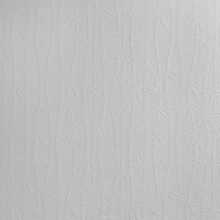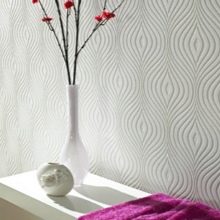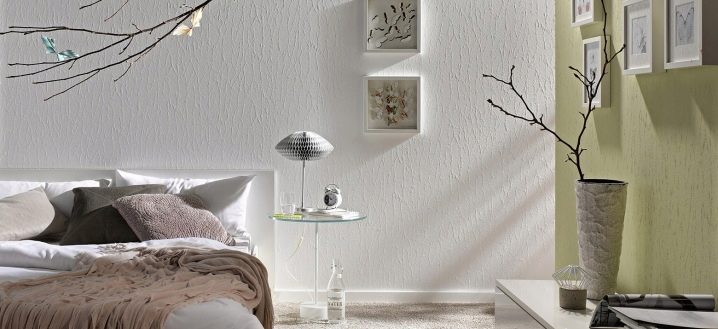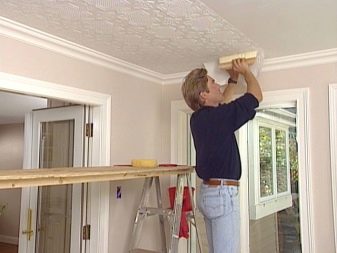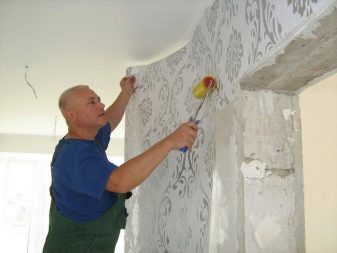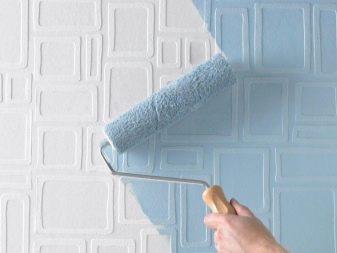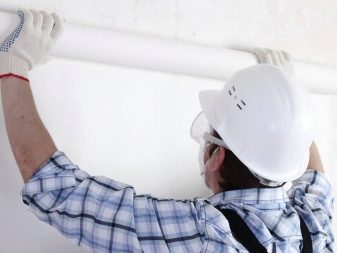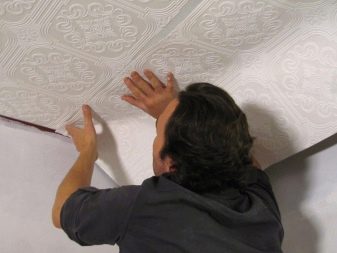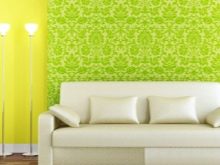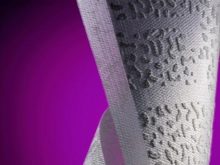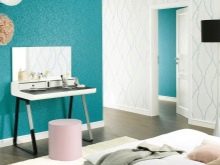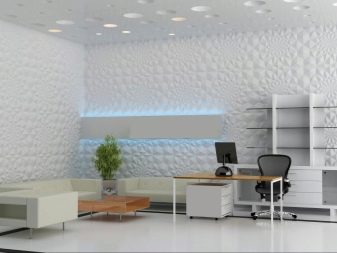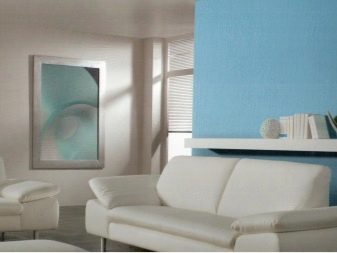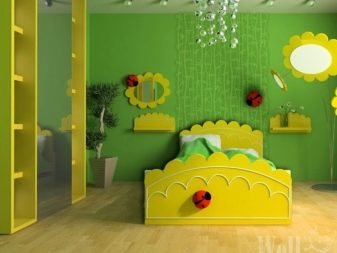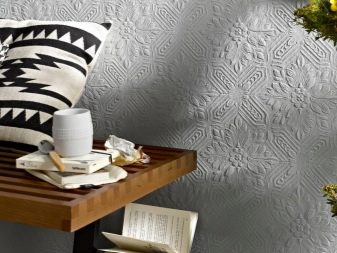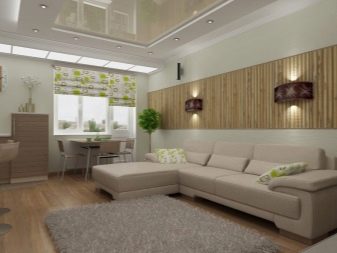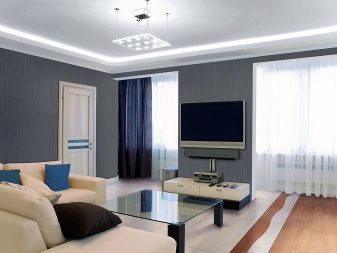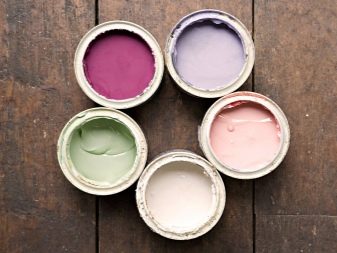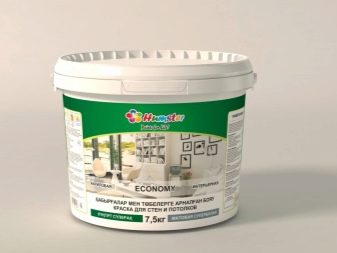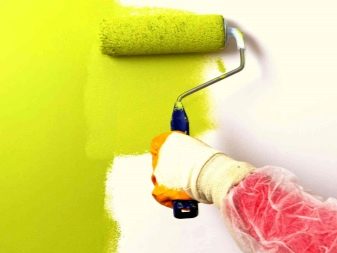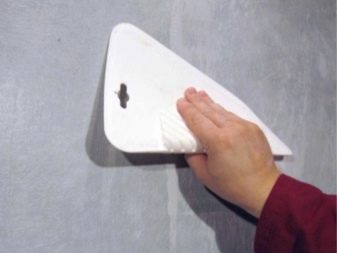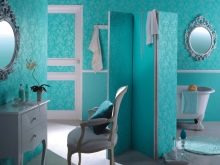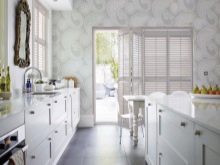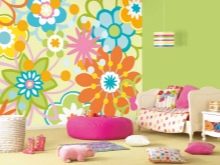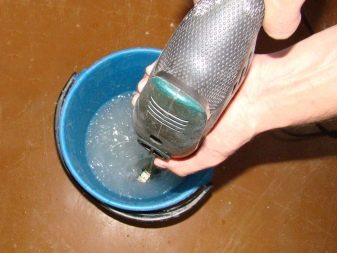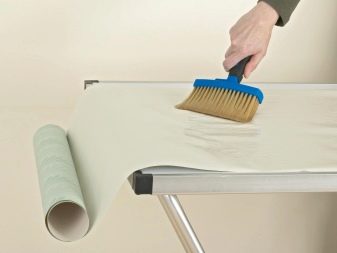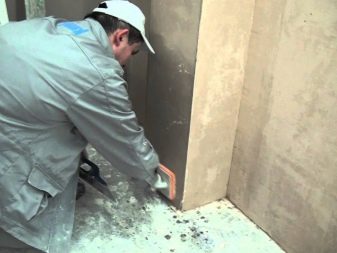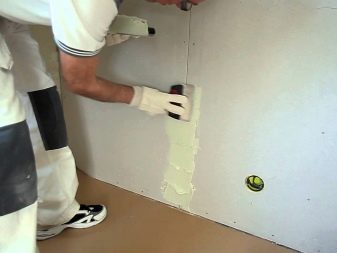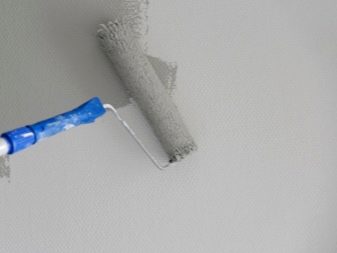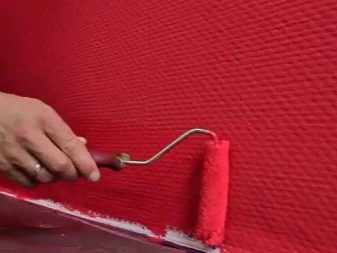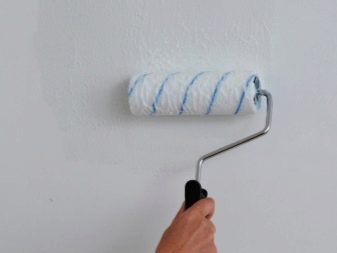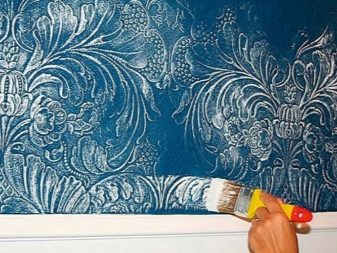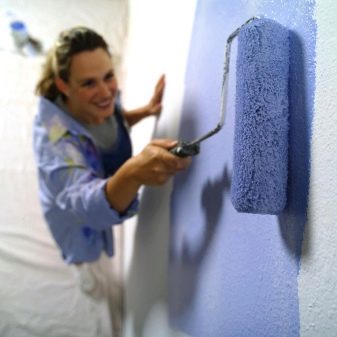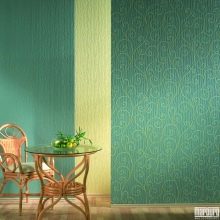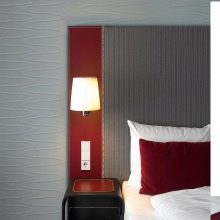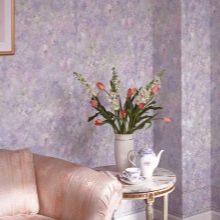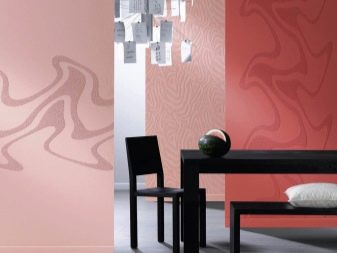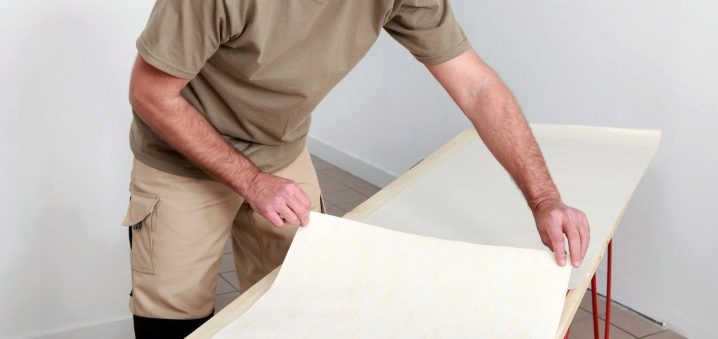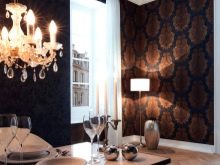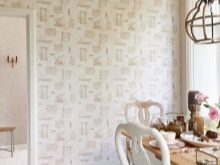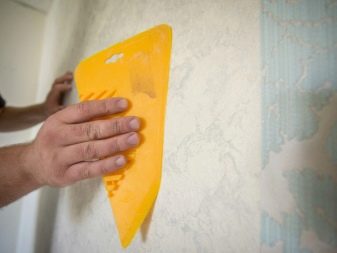Glass fiber for painting: material features
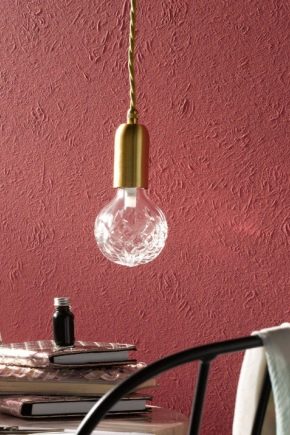
The construction market offers a lot of different materials for ceilings and walls. This wallpaper, and tile, and decorative plaster. But lately, glass wallpaper, which have already gained popularity all over the world, is causing an increasing interest among Russian buyers. It is necessary to understand what it is and why this type of finish is worth paying attention to when repairing.
Special features
Glass fiber is a material that is obtained by heating glass at very high temperatures (over 1000 degrees). After heating, filamentary fibers of various sizes are formed, which are woven into single webs.To impart enhanced strength characteristics, the surface is coated with starch adhesive. Thus, the structure and shape of the wallpaper is fixed. This glass contains quartz sand, limestone, dolomite and soda.
This type of finish refers to the roll materials. The most commonly used white glass wall paper for painting. Fiberglass surfaces are best painted with latex or water-based paints.
Types and characteristics
The majority at the thought of glass wallpaper imagines white rolls with an incomprehensible relief. In fact, there are two main types of fiberglass wallpapers:
- Smooth The sheets are made of sheet glass material of a translucent color. The most common name is "gossamer", which characterizes this species. They are used mainly for ceiling decoration, as they do not have a high density.
- Textured. In this case, the density is large, the relief is pronounced with various patterns. This type can be safely glued to the walls.
Quality wallpapers usually have a recommended density of 100 g / sq. m Depending on this indicator is determined by the grade of products:
- First grade. The best quality wallpaper with high density. They can be used to finish both walls and ceilings. Rolls for the sale of premium-grade wallpaper must have protective pads against damage during transportation.
- Second grade. Have lower quality characteristics. Sold in plastic wrap.
- Third grade. In this case, there may be a marriage, manifested in the defects of the patterns and protruding fibers.
The color gamut of glass wallpaper determines their purpose:
- The first group - light wallpaper (white and beige), designed for painting.
- The second group are different shades of paintings. They can be used as finishing.
Argued that glassmakers have a small selection of drawings. But modern technology does not stand still. The most common type of roll material with a small pattern. The textured pattern is repeated and is standard, therefore, it is in demand in the decoration of office premises. Patterns "matting", "herringbone", "cell" and other types in combination with pastel tones of the walls do not irritate the eyes and do not distract during work, making it difficult to concentrate.
The second type is made on special jacquard equipment. Patterns can be larger, diverse, and visually these wallpapers are more beautiful and more effective than ordinary ones. But the price of such canvases is much higher.
An important characteristic at the stage of selecting glass wallpaper, as well as other finishing materials, is their water resistance. According to this indicator, three types of glass fiber materials can be distinguished.
Each type is indicated by its own marking on the roll:
- One wave. Cloths with loose structure, practical not amenable to cleaning. You can handle them with a soft cloth without water.
- Two waves. In this case, you can allow yourself to use a damp cloth or sponge when leaving.
- Three waves. The most durable wallpaper allows you to cleanse yourself with any household detergent.
Characteristics of glass fiber:
- High density - ranging from 110 g / sq. m to 220 g / sq. m
- Long service life (Manufacturers talk about the use of wallpaper for over 30 years).
- Environmental friendliness and hypoallergenic. The method of manufacture and composition allows safely to use such a finish in bedrooms and in children's rooms.
- Antistatic.The surface of the canvas is not electrified, therefore, does not attract dust. Therefore, the wallpaper longer retain the original appearance.
- Ease of care and cleaning.
- Fiberglass is not exposed to microorganisms. Mold and fungus with such a finish will not be terrible, even in conditions of high humidity.
- No reaction to ultraviolet rays. The color does not change with the prolonged influence of the sun.
- The dense structure allows you to paint the wallpaper in any color without fear of blemishes and visible defects.
- Fireproof. Toxic impurities during combustion are not released.
- Glass fiber can be used under the putty as a reinforcing mesh to align the easy curvature of the walls.
All these positive properties of the material determine the consistency of its application. In this case, the price factor is important, but most buyers can afford various brands of glass fiber.
On sale there are standard sizes of rolls with a width of 1 and a length of 25 meters. They are quite light, so they do not cause problems in transportation.
Compare with other options.
The main rivals of fiberglass products in the construction market are non-woven wallpaper. Both types of canvases are used for painting.Products combine many similar properties: it is environmentally friendly, and fire safety, and vapor permeability, and durability. But fiberglass has its advantages: unlike flizeline ones, they do not collect dust, are more resistant to mechanical damage, and wash with water.
Their disadvantages are:
- The difficulty of dismantling. If you decide to change the finish, you must separate the wallpaper from the walls with the help of special compositions. This process is time consuming, long and dirty. High-quality interlining is separated without problems.
- Selection of glue. Glass fiber can be glued only by means specially designed for this.
- Paint consumption. The structure of the canvas involves a greater amount of paint applied, which is not very economical.
- The need for neat cutting. When cutting the material, the edges may crumble, so it is necessary to protect the skin and eyes.
In general, both types of finishes can be used equally well, and how to stay depends on your preferences and finances. (High-quality non-woven fabric is much more expensive). Fiberglass coatings receive good reviews from both professional craftsmen and regular buyers.Customers note the durability, strength and beautiful appearance of painted canvases.
The only caveat - finishers advise not to use glass products in new buildings. Material may be damaged during shrinkage. In this regard, non-woven wallpaper safer, since they can stretch and not give cracks and irregularities.
Tips for choosing
Sometimes it is not so easy to choose high-quality glass wall paper. It is sometimes impossible to visually distinguish a high-class product from a non-standard. Buyers sometimes are guided by the density and thickness of the material. But this is an erroneous criterion. A dishonest manufacturer can increase the consumption of impregnation to increase the density of the product. In the end, this will lead to the fact that after pasting the fabric are distorted, deformed, may decrease in size and lose elasticity. The clarity of the pattern structure can also be disturbed.
If you have the opportunity to pre-test the quality of wallpaper on a small piece, you should use it. Glue the canvas on the base, wait for drying, paint with a roller, slightly pressing. In case the surface has changed its appearance or deformed, such glass wall tile should not be taken.
If you have to choose fiberglass materials in the store without prior testing, follow the recommendations below:
- Check the quality packaging rolls and compliance with its declared grade.
- Trust famous brands. Popular manufacturers have earned a certain reputation and monitor the quality of their product. The choice can be stopped on the products of the Swedish brand Johns Manville with the “Tassoglas”, “Wellton” lines and the most famous in Russia “Virtulan”. The Czech manufacturer Vertex offers all the basic patterns of glass at affordable prices. China also did not stay away from the new trend. Nortex brand products compete with European counterparts and has a wide range of drawings.
- After determining the consumption of rolls, pay attention to their size. The standard is not always respected. Some manufacturers make products with a width of 2 meters or a length of 50 meters.
- Typical textures "herringbone", "gunny", "drops" may seem too boring to decorate bedrooms or living rooms. In this case, to complement the design of your rooms with modern and beautiful canvases, you can choose designer patterns made on jacquard looms.In this case, you get and high-quality and durable finish, and a spectacular appearance.
- Do not forget to pick up the gluewhich is specially designed for glass fiber.
How to paint?
First of all, it is necessary to determine the type of paint:
- The choice is better to stop on water-based or water-dispersion compositions, as they are the most environmentally friendly for use in homes.
- Styrene butadiene paints are waterproof and fit well, but can fade in the sun, so it is not advisable to use them everywhere.
- Polyvinyl acetate compounds do not have waterproof properties. With its low cost paint is very limited in scope.
- Acrylic dyes - the best option. The coating is not burnable, durable, waterproof and very durable. Color gains saturation and brightness. Simplicity in leaving and speed of painting cause the high price of a product.
The choice of a suitable paint depends on the type of room in which you will make repairs.
- In the living room is to give preference to the decorative effect of paint. The load on the walls is minimal. It will be enough water-emulsion composition or latex in the case of the embossed texture of glass fiber.
- In bathrooms and kitchen, first of all, water resistance and resistance to cleaning are necessary.Acrylic compositions are the most suitable, albeit expensive.
- Children's rooms, halls and corridors should withstand increased loads, so do not save on paint and give preference to acrylic.
The technology of painting glass fiber is not very different from other types of coatings, but it is worth considering some of the nuances:
- First of all, you need to wait for the glue, which the wallpaper stuck to the walls, to dry completely. Drying time is usually indicated on the packaging with the composition. But in any case, you should not start painting earlier than 24 hours after pasting.
- Room preparation is an important step that will save you from undesirable consequences. It is better to cover the floors with film materials, as well as stationary elements, you can optionally glue small parts with masking tape.
- It is better not to lower the primer stage. This will reduce paint consumption and ensure better adhesion to the surface of the wallpaper. As the primer composition can be used highly diluted adhesive for wallpaper.
- Coloring is usually carried out first in hard-to-reach areas: corners, joints. For this it is better to use small brushes.
- After processing the edges, you can paint over the main surface of the sheets with a roller. From work with brushes, even large sizes should be abandoned to achieve a uniform application of the composition and the absence of stains. If you put too much paint, the excess can be removed using a roller with foam rubber.
- When painting, you need to grab the adjacent sheets and do not allow them to dry to avoid visible seams. It turns out that you have to perform the entire painting process in one room at a time.
- Experts to obtain better coverage and color saturation is recommended to apply the paint in two layers. But before re-treatment the surface must necessarily be completely dry.
There are four methods for coloring glass screenings to achieve different visual effects:
- Application curbs. An excellent choice for finishing in a classic style of rooms with high ceilings. The main condition is that the drawing of glass culvert above the curb and under it coincides. The material is applied after the installation of the main canvases and their full readiness for further work. It is important to pay attention to the markup to get the most accurate result.
- Stencil. Will allow you to get original and unusual drawings on the walls. Perfect for decorating a bedroom or nursery. You can use blanks from shops or make a pattern yourself using masking tape.
- Squeegee technique. Gives a unique effect of overflow or flicker. Choose a basic tone, preferably deep and bright. Then apply a decorative composition with a glossy or metallic effect (you can choose from special varnishes). After that, remove the dye with a foam sponge. The decorative composition will remain only inside the relief and will give a beautiful shine.
- Azure. On a dried base tone it is necessary to apply short transverse lines with azure with a flat brush. After 15-20 minutes, distribute the composition over the entire surface with a rubber spatula. Visually, it looks like a blurry picture. You get a unique decor.
Useful tips
When working with glass wallpaper, problems may arise in violation of the technique of work. And, of course, you should know what to do if you are tired of your decoration.
How to repaint a different color?
For a start, it is important to understand that it will be difficult to turn dark saturated walls into white or pastel.Pick colors that are close in brightness and shades. Paint is better to use acrylic, because it will best cover the previous color. Need to paint in two sets. In one layer, you risk achieving blur and a dirty effect on the surface. It is important to choose the right tool. It should be a spray or roller with a large pile so that it can penetrate inside the recesses in the figure.
If you plan to repaint the wallpaper more than once, choose a glass-fiber with a deep relief. After all, each application of paint will reduce it and will be able to spoil the drawing.
What if unstuck?
If you find that some painted areas of wallpaper began to peel off from the walls, this is most likely the result of incorrect conditions when sticking. Indoors could be a draft, too low a temperature or excessive humidity. Also, the problem often arises in the kitchen, because without hoods over the kitchen unit, air circulation and heat transfer are disturbed. Only one way out - if possible, eliminate temperature fluctuations, dry the room, if necessary, apply a primer to the damaged areas and re-paste.
Wallpapers can peel off if you forget to apply a primer, or the walls are too cold, or the adhesive is not suitable for fiberglass.
In any case, the technique must be observed with precision, because it is very difficult to completely remove the damaged canvases and there is a big risk of damaging the neighboring sheets.
How to remove bubbles?
Bubbles are most often formed after gluing glass screening as a result of uneven application of glue to the wall or moisture. Such a defect is easy to fix with your own hands. It is necessary to use an ordinary syringe and deliver the glue to the problem area. Then carefully level the surface with a soft roller.
About what features of the material glass fiber under painting, see the following video:

